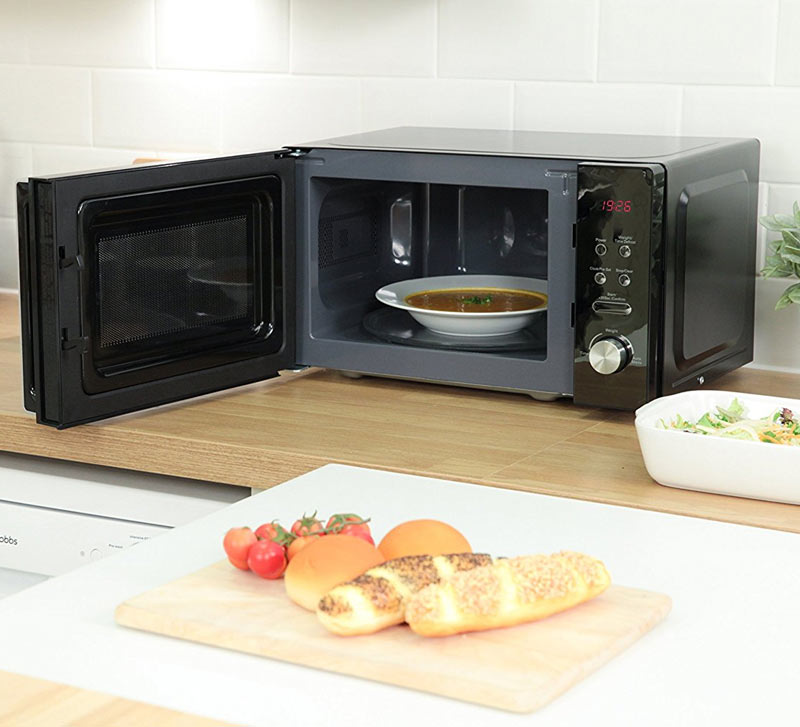The microwave oven is an essential kitchen appliance – and has been for several decades. But how do they cook food? And why are they so much faster than other methods of cooking? Keep reading to find out!
Microwaves have become a mundane part of modern life – but they are actually an astonishing example of modern technology. Food that used to take hours to cook can now be cooked in minutes, while microwaves also bring a level convenience that we take granted.
The key to a microwave’s efficiency is the useful properties of low-frequency light. In contrast to a convection oven, which uses a heated cavity to cook food from the outside, a microwave uses radio waves that can penetrate deeper into food. This is why microwaves cook faster and more evenly than a regular oven.
But how does a microwave generate radiation to cook food? And is it safe? Keep reading to find out!
When were Microwave Ovens Invented?
A common theme with world-changing inventions is that they often happen by accident – and the microwave oven is no exception.
In the 1950s, a scientist called Percy Spencer was researching using magnetrons (more on these later) for navigation. On the day of his “breakthrough,” he was surprised to notice that a chocolate bar in his pocket melted when he turned on the magnetron. Being a clever guy, he quickly realised that the heat generated by a magnetron could be used to cook food.
As you would expect, his first attempts to make a commercial microwave oven were fairly uninspiring. But over time the ovens became more efficient, quick and compact. Today, there are millions of microwave ovens being used around the world.
How a Microwave Oven Works
As the name suggests, microwave ovens use microwave radiation to cook food.
Microwaves are part of the same electromagnetic spectrum as visible light. They have a longer wavelength and lower frequency than the light we use for vision, although if they are directed onto skin they can still cause burns. This is because microwaves carry large amounts of energy.
Here’s an overview of how a microwave oven generates microwaves and cooks food:
- Microwaves are generated by a magnetron. This is a device that converts electric energy into microwaves with high power.
- The microwaves are directed into the cooking cavity.
- All the microwaves emerge in a single direction, so food is rotated within the cavity to cook more evenly.
- The cavity is built with metal walls that reflect microwaves. When the microwaves reach the food, they pass through the surface and transfer energy into molecules inside.
- This extra energy causes the molecules to vibrate, which heats up the food.
- Even after the microwave has stopped, heat continues to spread through the food. This is why microwave instructions often tell you to leave the food to stand.
The speed and effectiveness of a microwave oven largely depends on the type of food. Liquids are heated more efficiently by microwave radiation, so moist foods will cook evenly throughout. Foods that contain more liquid inside, such as pies, often cook faster in the middle than the exterior.
Microwaves also only penetrate to a depth of around 2cm. This means larger items are cooked from the outside in (as the exterior heats up, heat is transferred into the centre of the food).
Are Microwaves Safe?
Microwaves can be harmful to living cells and can be extremely dangerous to humans. Fortunately, there’s no need to worry. All ovens are built with a metal case, as this stops the microwaves from escaping. The windows are also built with a metal mesh. While we can see through the mesh, the gaps are too small for microwaves to pass through.
Assuming that a microwave oven is functioning correctly, they are safe to use. Damage to a microwave oven can make them dangerous though. For this reason, never attempt to repair your microwave yourself. You should also be wary of a microwave with a door that doesn’t shut correctly – although most ovens have safety features to prevent the magnetron switching on when this happens.
Are Microwaves Energy Efficient?
There’s a lot of confusion over whether microwaves are energy efficient. Some people just see the “800W” label and assume this must mean microwaves use more energy than a regular oven. Others think microwaves are more efficient as they can heat internally rather than just “out to in.”
The truth is that microwaves are usually faster and more energy efficient. This is largely because you don’t need to pre-heat a microwave before it can start cooking.
Even so, a microwave oven might not be as energy efficient as you’d expect. Magnetrons cannot convert electricity to microwaves without wasting some energy as heat. Modern microwaves also require power for digital displays, turntable, cooling fans and other electronics. These all reduce efficiency.
For this reason, microwaves shouldn’t be used for tasks such as boiling hot water. A kettle can use much less energy to do this. For most meals, however, a microwave oven is generally an energy efficient choice.
Another thing to note is that the listed microwave power is the output, not the input. Most microwaves require almost double the input power (e.g. a 700W microwave often needs 1300W-1400W input power). This is a clear reminder that microwaves are far from perfectly energy efficient. It’s also something to keep an eye on when looking to buy a microwave.
Summary
Microwave ovens have become commonplace in our daily lives, which means we often forget how convenient they are. When functioning correctly, they provide a safe, fast and energy efficient way to cook food without needing to pre-heat an oven.
Do you have any questions about how a microwave works? Feel free to ask us in the comments section!

